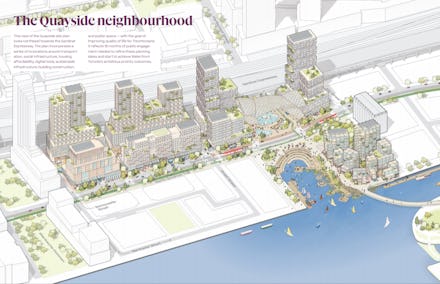It seems like Google is everywhere these days. Chances are it manages your inbox, your documents, your photos, video chats, personal assistant, phone or all of the above. It turns out, devices and software are only a small part of the company’s vision for its future. In 2015, Google’s parent company, Alphabet, launched an urban planning and development organization called Sidewalk Labs. Led by CEO Dan Doctoroff, the firm has been in talks with the city of Toronto to take over a section of its eastern waterfront and build Sidewalk Toronto, the massive, sustainable, high-tech, utopian, treehouse mini smart city of every urbanist’s dreams.
Though discussions have been underway for nearly two years, this week Sidewalk released an official 1,500 page master plan for the Quayside portion of the project which it calls a “complete community and a great neighbourhood in its own right.” While the document is full of high-quality imagery and exciting innovations, as the relationship between the company and the city has deepened, Sidewalk Labs has been heavily criticized by local activists who are concerned that the city is signing up to become Google’s next big data mine.
The project began in 2017 when Toronto’s waterfront district released a call for proposals to redevelop the 12-acre area. According to Sidewalk Labs they, “sought to use Quayside as a demonstration for how advances in technology and design can yield substantial improvements in quality of life; instead of seeking modest sustainability gains, the[y] sought an extraordinarily ambitious goal: a climate-positive community.” While Sidewalk Labs has yet to break ground in Toronto yet, it has since opened a small headquarters where it has been demonstrating proof of concept ideas for these innovations to the public. These range from its signature sustainable mass timber building designs to light rail and modular sidewalk tiles that generate electricity from pedestrian traffic and heat up in the winter to melt snow and ice.
Construction is expected to begin within the next two years, if the master plan is approved, and be complete by 2040. At that point, Sidewalk estimates that the revamped waterfront community will generate up to 93,000 jobs, $4.3 billion in tax revenue each year, and $14.2 billion in GDP growth per year. Toronto is already a diverse, highly educated city with a growing tech sector. It is also relatively affordable compared to cities like Seattle, San Francisco, and New York. Sidewalk Labs and Toronto are banking on the project bringing in new growth in addition to establishing the city as the epicenter of a new wave of sustainable urban design.
When Sidewalk Labs first proposed the idea to the city, their proposal seemed restricted to urban tech innovations like the ones mentioned above. However, as time has gone on, the scope of Sidewalk Toronto has expanded, literally and figuratively (the original proposal covered 12 acres and that has since expanded to 178 acres) with a series of revelations coming out that the Google subsidiary has far more ambitious plans for housing, transit, and public life.
As with any smart technology from your phone to a driverless car, sensors are key. Monitoring everything from light, sound, temperature, location, and usage patterns sensors are responsible for collecting the data that is supposed to make our lives easier and more efficient. That said, being creeped out by targeted ads is one thing, but Google has plans to blanket the waterfront development with sensors in everything from its buildings to its streets and has plans to encourage civic engagement and community development through its own set of apps that will also, surprise, be collecting data on residents. Ostensibly, all of this is merely necessary for a smart city to function — data on pedestrian traffic isn’t to track where you’re going, it’s just to collect data on commuting patterns so Google can figure out whether it should adjust a sidewalk. Unsurprisingly, some local residents are less than happy about the city government being willing to turn over its citizens to this level of data collection.
After lengthy discussions, Sidewalk has agreed that all of the data collected from the sensors won’t be sold and will be managed by an independent data trust, however privacy activists remain worried given Google’s overall track record on handling private information. Before the Quayside plan can be approved, Sidewalk will need to get the go-ahead from Waterfront Toronto along with the city, the province of Ontario, and the Canadian federal government.
"If somebody is always going to be opposed to a tech company playing a role in their city, then it's going to be hard to convince them, but I also hope people will begin to understand Sidewalk Labs for what it is," Doctoroff said. "What we are is a place-making company."
Right now the project is a mix of master planning documents, public forums, and high-end marketing. While the increasing complexity and acreage of Sidewalk Toronto continues to grow, reactions continue to waver between fear and cautious optimism for the city that big tech plans to build.
